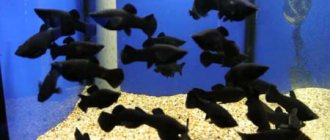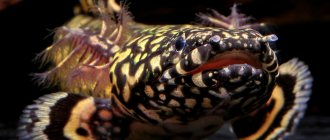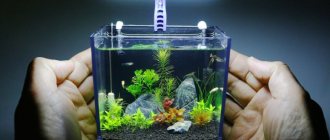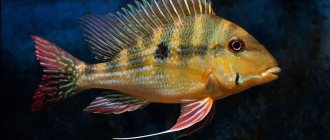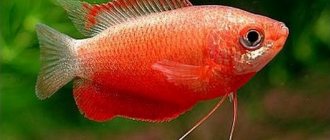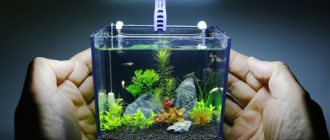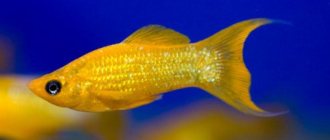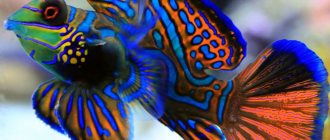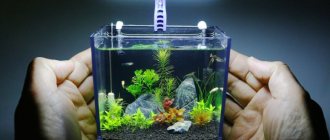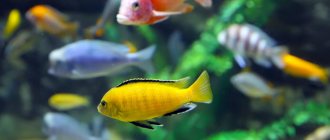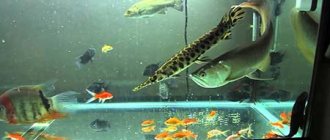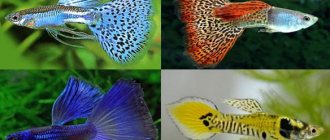Mistus is a catfish that reaches a length of 20 centimeters in natural conditions. In the aquarium, the fish is an order of magnitude smaller, but on average, about 10 cm. The body of the catfish is elongated, slightly compressed on the sides. The head is large and has large eyes. The color of mysthus is pink-yellow, which can give a blue-violet tint. Mystus got its name “striped” due to the horizontal stripes on its sides.
Mistus, although he has a peaceful character, loves to pick on his neighbors. He can easily eat small fish that are no larger than his mouth, mistaking them for food. Therefore, neons, zebrafish and similar individuals should live in a separate aquarium. You should not place fish with large tails together with mystus. This threatens that the cocky catfish will spoil the appearance of its neighbors by pinching their tails and fins.
For the striped mystus to feel comfortable, it will need an aquarium with a volume of at least 150 liters. You can accommodate two more brothers with him. Catfish of this species are mobile, so they require a large aquarium so that they can move freely in any direction. The larger the volume of the container, the larger the mystus will grow.
Many catfish are nocturnal. Mistus belongs to those several subspecies that do not sleep during the day. They swim around the aquarium, pester fish, and undermine plant roots in search of food. During rest, the catfish hides in a shelter and can either sleep there or wait out danger. For these purposes, the aquarium must have driftwood, stones, plants and decorative caves.
Catfish mistus is unpretentious in food. You can feed him almost anything - dry, frozen or live food. He will gladly eat a portion of food of some slow-moving fish. So that all the inhabitants of the aquarium remain full, and the catfish does not suffer from overeating later, you need to first pour food for it so that it settles to the bottom. And then you can feed the rest of the fish. The most important thing is not to pour too much food into the aquarium. Everything that the fish don’t eat will go to the catfish from the bottom. And this is fraught with sad consequences.
If you want to breed mistuses, you cannot do it with biological processes alone. You will have to use special drugs that stimulate spawning. But now everything can be purchased at pet stores, so breeding catfish is quite possible in a home aquarium.
History and description
The most ancient fish of the ray-finned family. From the Paleozoic era to the present day it has remained unchanged.
The body shape is serpentine, rounded on the sides, unlike eels, fleshy pectoral fins, a wide crocodile-shaped head, gill covers arranged in the form of a mosaic, and unusual diamond-shaped scales on the body. The unusual appearance of Polypterus is adorned with a truly “dragon-like” crest on the spine and a mustache that would be the envy of the most mustachioed catfish. Color with a blue tint, silver-gray. An even rarer species, polypterus gray albino, is distinguished by its milky white color with a marbled tint. Even its way of moving along the bottom is unique: with the help of powerful pectoral fins, it walks sedately, causing admiration among spectators.
Diseases and prevention
Striped catfish, like other aquarium fish, are susceptible to diseases resulting from improper care. Due to the lack of scales, they are treated with drugs: Pimafix or Melafix. Potassium permanganate and other medications containing copper will have a negative effect.
Platydoras have sharp spines and can be damaged when moving when entangled in nets. The whiskers, with the help of which the catfish obtains food for itself and orients itself in space, are harmed by the high content of nitrates in the water. To reduce it, it recommends weekly water changes and maintaining the level of the hazardous substance within 20 ppm.
Sources:
https://fanfishka.ru/akvariumnye-stati/akvariumnye_rybki/1633-mistus-polosatyy-som-soderzhanie-sovmestimost-foto-video-obzor.html https://pets2.me/bok/1182-akvariumnaya-rybka-mistus -mystus-vittatus-polosatyy-somik.html https://mrhvost.com/platidoras
Structural features
And all the “highlights” of Polypterus did not end there: its swim bladder has two chambers, one of which plays the role of a lung, so they must always have access to air. He also cannot breathe only atmospheric air, so in the wild he must live in creeks with a calm current, feeding on small fish and everything he can get.
In extreme drought conditions, it is able to survive in minimal volumes of water; there are known cases of Senegalese polypterus migrating over significant distances to the nearest body of water by land with the help of strong pectoral fins and the ability to breathe the atmosphere.
When kept at home, he often comes to the surface for air, which also ensures constant attention to himself.
Description of appearance
The body is long, shaped like a spindle, with a forked caudal fin, of impressive size. The head is massive, with protruding, large eyes. Two pairs of mustaches serve as both decoration and an organ of touch. The antennae on the upper lip are much longer than on the lower lip. In the dark, Mistus uses them to feel objects and plants.
The tall, dorsal fin consists of wedge-shaped, transparent rays. The fins on the chest and abdomen are small.
Endemic to South Asian countries - Sri Lanka, Bangladesh, India and Nepal. In the wild, it reaches a size of 45 cm. Schools of these predators can be found both in freshwater lakes and at the mouths of rivers with brackish water that flow into the sea or ocean.
The Killer Whale catfish family, to which the Mystus catfish belongs, is an active aquarium fish that grows up to 20 cm when kept at home.
The body color of males is slightly more contrasting. They are noticeably smaller and slimmer than round females. The main distinguishing feature of adult males is a special process called the urogenital papilla (genital organ).
Conditions of detention
It is very unpretentious in captivity, thanks to its rather large size for home breeding, and it requires a lot of space: in an aquarium of less than 300 liters, there is no point in breeding polypterus. Temperature: 25-28°C; acidity 6.2-8.5 pH; hardness up to 20°dH, aeration and water filtration also need to be given the proper level of attention. Water changes are at least a third weekly, but polypterus is indifferent to plants - the main thing is that you can play in them and hide in excessive daylight.
Parameters of the aquatic environment
Beginners should not get Mystus striped, as this fish requires care and constant monitoring of water parameters, to which it is extremely sensitive. The following parameters are considered optimal for keeping Asian catfish:
- hardness – up to 24;
- temperature regime – from +22° to +27°С;
- acidity – about 6-7.
You will also need to equip the tank with a good filter and aerator.
The striped mystus is a big tidy person, so the tank where it lives will have to be cleaned regularly and the water replaced at least a quarter of the time every week.
This procedure will also reduce nitrate levels in the aquatic environment, which have an extremely negative effect on the condition and health of representatives of the catfish family.
Striped mystuses prefer moderate and slightly diffused lighting. They cannot tolerate bright, intense illumination, as well as a lack of light.
Lifestyle
By nature, Polypterus is a nocturnal predator, so in captivity it is especially interesting to watch hunting in the evening. His eyesight is weak, his only hope is his subtle sense of smell, thanks to which he tracks down prey. The relatively small size of the mouth allows it to swallow only small inhabitants of water bodies.
The fish glides up and down the aquarium, chasing prey and jumping out of the water to breathe. Additional safety measures would be useful: the aquarium should be closed with a lid so that the fish does not fly out of the water, but the water should not reach the top - it is necessary for the respiration of the polypterus.
Adult polypteruses are highly resilient and survive in the most unfavorable conditions, but it is still better to create a cozy home for your pet. Moreover, this species is still exotic in our pet stores and has not yet become widespread, despite genuine interest from lovers of the unusual.
Mr. Tail Recommends: Aquarium Basics
Platidoras live at the bottom, choose a wide and low tank, 40-50 cm is enough, capacity is from 120 liters per individual. Fresh water is poured, hardness 1-1.5 °dH, acidity 6-7.5 pH, temperature +25...+30 °C. Need increased aeration. Filtration is set to medium, with a weak flow. Once a week, one third of the total volume is replaced. Pets raised in an artificial environment are able to withstand increased temperatures and short-term coolness.
These catfish love shelter; driftwood and cut plastic pipes are placed on the bottom, and the aquarium is filled with vegetation. Choose one floating on the surface (elodea, hornwort), it will shade the light. They feel uncomfortable in bright light.
Platydoras burrow into the ground, so rooting algae is not recommended. To prevent harm to the fish, cover with a mixture of sand and fine gravel.
Living in an aquarium
Polypterus is a nocturnal hunter, so it is necessary to create a little shade in the aquarium with the help of plants and decorations; it loves driftwood of unusual shapes; during the daytime it can hide in caves of a suitable size; it is unpretentious in the choice of plants. Fine loose soil of dark shades will look more organic; fish will not dig into it and harm the algae, so the main emphasis is on beauty, not practicality. The cleanliness of the bottom is very important; the rather large size of the pet, even when walking slowly, will raise silt upward and cloud the water.
During the day, Polypterus will mostly walk sedately along the bottom, resembling a small crocodile; the night will be devoted to hunting and games.
Mystus behavior
Mistus is active mainly at night. During the day he can swim around the aquarium, but extremely rarely. At night, on the contrary, it swims and hides in shelters: if you suddenly turn on the light in the room, the mystus will hide in some snag in a matter of seconds.
Mystus striped is a very active fish; for it, the aquarium should have a lot of grottoes, snags, shells, skulls and other structures.
Mistus loves to misbehave, tease other fish, and even gnaw on the long fins of other inhabitants, thinking that they are plants. You need to remember: the striped mystus is a predatory catfish that will hunt and sooner or later destroy all the small fish. It is better to keep it in the company of large fish, which the catfish will not perceive as a victim. Catfish can sort things out among themselves, but, as a rule, without serious consequences.
There is one more feature that you need to know about when buying this fish. Thus, mystus can gnaw young leaves of aquarium plants, thus preventing them from growing and developing. It is recommended to try to “make friends” of the catfish with vegetation, for example, feeding it with scalded young nettles and fresh lettuce leaves.
Feeding
A very interesting sight is the feeding of Polypterus, reminiscent of a similar process with dolphins. Senegalese polypterus is a fairly smart fish and quickly learns not only to recognize the owner and feeding time, but also to take pieces of food from hands. They are unpretentious in food, all types of food for predators are quite suitable for them, small fish and larger pieces of fish also do not cause rejection. After some training, they can easily eat “land food” - beef heart, earthworms, as well as shrimp and squid. Easily switches to dry food. It is very easy to determine whether a pet is full or not - it stops coming to the surface for treats, so excess food will not pollute the aquarium.
Compatibility with other fish
The best option for keeping Mistus would be a species aquarium (somyatnik). Although the species is considered peaceful, it is not so easy to find neighbors for the cocky catfish. Neighborhood with guppies, neons and barbs is excluded, since all of them will be considered as food.
Larger, veiled species will get tired of constant “catching up” and will end up with bitten fins.
It is possible to live together with other catfish or with larger non-aggressive fish with small fins (macrognathus, cichlids). But even in this case, games and races in the aquarium are guaranteed.
Reproduction
Despite their unpretentiousness, polypterus reproduce in captivity rather poorly. The eggs are thrown all over the surface of the aquarium and then eaten, so they have to be collected and planted separately. Feeding the fry is difficult: the food must be live and small enough, Artemia nauplii are ideal for this purpose, but after a feast, uneaten individuals have to be removed from the aquarium every time - the babies will not eat carrion, and the decomposition of the remains leads to infection with pathogenic bacteria. Individuals that have grown up to 30 cm are considered adults and are ready for further reproduction.
Breeding
Mystus becomes sexually mature at the age of one year. For reproduction, 2-4 males are usually chosen per female, but pair spawning is also possible.
You need an aquarium with a volume of 100 liters or more. Water temperature is 26C, acidity is unchanged (6-7pH), and minimum hardness is 4dH. Moss, loofah or small-leaved plants are used as a subtract.
Breeders need to be fed a variety of high-protein foods. After the female has collected eggs, special injections should be given (bream pituitary gland mixed with a hormonal drug). Unfortunately, no evidence of reproduction in captivity without stimulants has been recorded.
After this, you will need to change the water (if it is cloudy from milk) and, possibly, special expressing of the female’s eggs. The eggs take approximately 30 hours to develop. Ciliates are used as the first food; after a couple of days, Artemia nauplii can be introduced into the diet.
Large fry can eat small ones, so calibration is necessary. Babies grow quickly and at the age of three months the sex of the catfish can be determined.
Neighbors in the aquarium
When planning to purchase a Senegalese polypterus for your home aquarium, keep in mind: the fish will defend its territory and actively hunt. If there is not enough space or the reservoir is densely populated, conflicts between adult polypterus are possible; all other neighbors are considered only from a gastronomic point of view. Still, it is better to keep a separate, fairly spacious aquarium for them.
The only acceptable neighbors of Polypterus are medium-sized cichlids, labyrinths and barbs. It can get along with other non-territorial species of aquarium fish, provided that it cannot hunt for them due to the small size of its own mouth, and they do not express aggressiveness towards it and lay claim to its territory and food.
A beautiful and unusual pet, the Senegalese polypterus will quickly win the love of all household members and become an exotic miracle in your home.
Siamese killer whale: content, description, photo, reproduction
The Siamese killer whale (pseudomystus siamensis, leiocassis siamensis), and not the killer whale, as is found in most searches, is a representative of the killer whale catfish family, which is found exclusively in fresh water bodies of South Asia.
In an aquarium it reaches a maximum of 12cm, in nature it can grow up to 20cm. Sexual dimorphism is weakly expressed; it is possible to distinguish a male from a female only by its smaller and more slender body.
The lifespan of the Siamese killer whale catfish (correctly Orca) is about 5-6 years.
Maintenance and care, arrangement of the aquarium
The optimal tank size for one catfish starts from 40 liters. It is recommended to use dense thickets of rooting plants and various driftwood in the design. The lighting is subdued; a few clusters of floating vegetation will further shade the aquarium. It is desirable to bring water conditions closer to natural ones, that is, not only bring the pH and dGH values to close values, but also use materials that will saturate the water with tannins and tannins and thereby give it a tea-like hue. Suitable materials include natural stained wood, dried oak leaves, leaves and bark of the Indian almond tree. Nevertheless, the catfish is able to adapt to other living conditions.
Mystus tengara
In my opinion, Mystus striped is undeservedly ignored by lovers of aquarium exotics. This is a very attractive fish in appearance and interesting in behavior. The white belly and stripes on the body shine with mother-of-pearl, long whiskers and winking eyes give the fish a very extravagant appearance.
Features of keeping mistuses
There is evidence that these catfish can spoil living plants by gnawing on their tender young leaves. You can try to “make friends” of catfish with plants by feeding them with plant food: lettuce leaves, scalded nettles.
Feeding mystus
Mistuses are very fond of special tablets for catfish. When I feed them to my mystus, he rushes like lightning into a pile of fish, grabs the tablet and runs away. After about five minutes he usually loses it and swims for another. These catfish are unpretentious in food, they eat absolutely everything: dry, frozen, and live food.
Water for mistuses
They require standard settled water with a temperature of about 25 degrees; it is enough to change it once every two weeks.
Breeding Mystus
You can try and breed them, but this requires stimulation of the fish using pituitary injections, which, of course, is not available to all hobbyists. Therefore, it would be better to just watch these catfish and get aesthetic pleasure from them.
Caring for Platydora striped
Representatives of the species are unpretentious in care. Calmly survive temporary temperature fluctuations. They easily adapt to changes in the chemical composition of water (hardness, acidity), which is renewed by the owner by 1/3 every week.
From the editor: Peat for treating aquarium fish
In natural conditions, striped platidoras like to bury themselves in river silt. It is necessary to recreate their natural habitat as much as possible. To do this, before starting the aquarium, take care of the soil with sand and fine gravel with rounded edges.
Facts, knowledge of which helps to properly care for catfish and prevent diseases:
- increased nitrate content is the cause of mustache diseases;
- excessive accumulation of organic matter at the bottom causes necrosis of the fins;
- using a jigging net with a loose mesh leads to injury to catfish;
- unbalanced food weakens platidoras.
Before use, decorative elements are washed. Purchased fish are kept in quarantine before being released into a general-species aquarium. If you ignore these rules, the risk of infection increases.
Twice a month it is recommended to wash the equipment, clean the walls of the indoor pond from algae deposits, and remove the remains of fish from the soil with a siphon. Exemplary cleanliness, proper maintenance and care maintain health and increase the lifespan of aquarium catfish.
Polypterus video compilation
https://youtube.com/watch?v=CWO5qiqBuS0
+
Category: Aquarium articles / Aquarium fish | Views: 25 557 | Date: 5-11-2017, 14:56 |
We also recommend reading:
- — The crucian carp have learned to ferment sugar into alcohol!
- — Clarius
- — Cichlazoma Eliot
- — Biotope aquarium as a form of aquarium art!
- — Arowana
